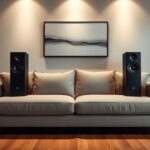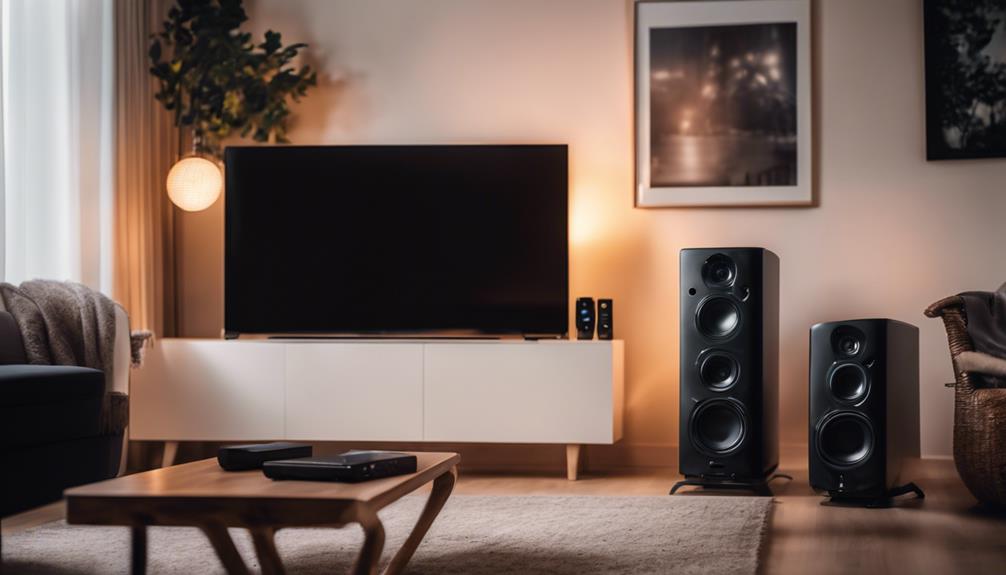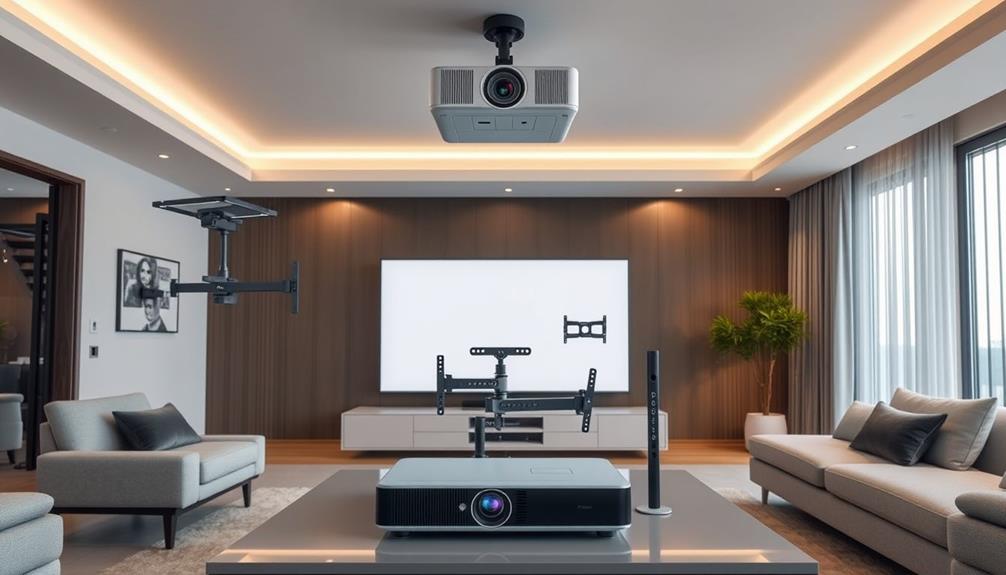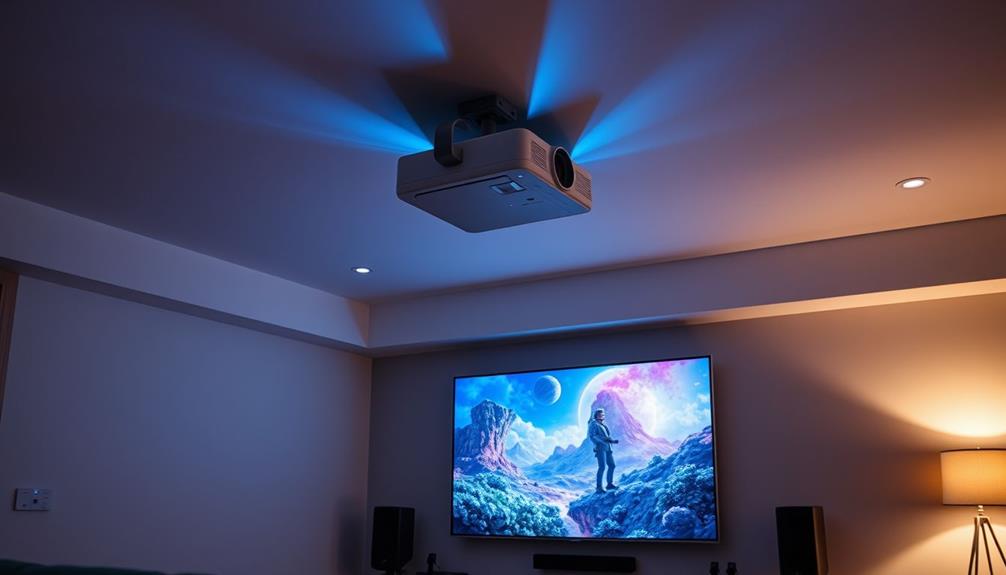To create a multi-zone home theater with whole-home audio, start by planning your space and choosing ideal speaker locations at ear level for balanced sound. Use wired or wireless systems with in-wall or ceiling wiring for a clean look and reliable performance. Select multi-zone amplifiers or smart hubs for independent control of each zone and different sources. Properly wiring and placing speakers boosts sound clarity, creating a versatile setup. Keep exploring for detailed steps to design your system seamlessly.
Key Takeaways
- Plan room layouts and speaker placement to ensure even sound distribution and optimal coverage in each zone.
- Choose scalable wiring and wiring routes that support future expansion and minimize installation challenges.
- Use multi-zone amplifiers or smart hubs for independent control and source management across different areas.
- Opt for discreet in-wall or ceiling speakers to blend with decor while maintaining sound quality.
- Test and adjust speaker positioning and wiring configurations to achieve balanced, clear audio throughout the home.

Have you ever wanted to enjoy different music or TV in multiple rooms simultaneously? If so, creating a multi-zone entertainment system with whole-home audio might be just what you need. The key to a seamless experience lies in thoughtful speaker placement and wiring configurations. Proper speaker placement ensures each room delivers clear, balanced sound, while wiring configurations determine how easily you can control and expand your system.
Start by evaluating your space. Think about where you’ll want sound and how the rooms connect. When it comes to speaker placement, aim for strategic positioning. Speakers should be placed at ear level and away from walls or corners that could cause sound distortion. For living rooms, a central location usually works best, while in bedrooms or kitchens, you might prefer speakers mounted on walls or ceiling speakers that blend seamlessly into the decor. This careful placement helps produce an even soundscape, avoiding dead spots or overly loud areas.
Strategically position speakers at ear level, away from walls, for balanced, clear sound throughout your home.
Wiring configurations are equally critical. You can choose between different setups depending on your needs and budget. A common approach is a wired system with speaker wires running from a central amplifier or receiver to each speaker. This setup offers reliable sound quality and minimal interference. For simpler installations, in-wall or in-ceiling wiring keeps wires hidden, maintaining a clean look. Alternatively, wireless solutions can be easier to install but may require stable Wi-Fi and can sometimes introduce latency or interference. Whichever wiring configuration you select, ensure it’s scalable so you can add more zones or speakers later. Running cables through walls or ceiling cavities requires planning, so you don’t have to redo your work later.
Control is another important aspect. A well-designed wiring configuration allows you to assign different audio sources to each zone and control them independently or simultaneously. You might use a multi-zone amplifier or a smart home hub that integrates with your Wi-Fi network. This setup enables you to enjoy jazz in the kitchen, rock in the living room, and silence in the bedroom—all at the same time, with just a tap on your smartphone or remote.
In short, creating a multi-zone system starts with deliberate speaker placement and thoughtful wiring configurations. By considering where to position your speakers for ideal sound and choosing wiring options that match your home’s layout, you’ll set the foundation for a versatile, scalable whole-home audio experience. Additionally, selecting proper wiring configurations can help minimize interference and ensure consistent sound quality across all zones. Once set up correctly, you’ll enjoy the freedom to listen to different content in every room, enhancing your home entertainment like never before.
Frequently Asked Questions
What Are the Best Brands for Multi-Zone Audio Systems?
You should consider brands like Sonos, Denon, and Yamaha for multi-zone audio systems. They offer excellent wireless connectivity and broad speaker compatibility, making setup and expansion easy. Sonos is especially known for seamless multi-room integration, while Denon and Yamaha provide versatile options for different budgets and preferences. These brands guarantee reliable performance, simple controls, and a great listening experience across multiple zones in your home.
How Much Does a Whole-Home Audio System Typically Cost?
A whole-home audio system typically costs between $1,000 and $10,000, depending on your needs. Cost considerations and budget planning are essential, as factors like system size, brand, and features influence the price. Basic setups for small homes can be more affordable, while larger, high-end systems with premium components will set you back more. Always compare options to find a solution that fits your budget and desired quality.
Can Existing Speakers Be Integrated Into a New System?
Think of your existing speakers as pieces of a puzzle waiting to fit into a new picture. You can usually integrate them into your new system, but you need to check speaker compatibility and wiring considerations first. Make sure your current speakers can handle the power and impedance required by the new equipment. If wiring is outdated or incompatible, you might need to upgrade or adapt it, like tuning the strings before a concert.
What Maintenance Is Required for Multi-Zone Setups?
You need to regularly perform speaker calibration to guarantee ideal sound quality across zones. Additionally, wiring inspections are essential to catch any loose or damaged connections that could affect performance. Keep your system clean and dust-free, and update firmware as needed. By staying proactive with these maintenance tasks, you’ll maintain a reliable, high-quality multi-zone setup that delivers consistent audio throughout your home.
How Do I Troubleshoot Common Audio Distribution Issues?
You should start by checking speaker placement to guarantee ideal sound distribution and avoid dead spots. Inspect wiring connections for any loose or damaged wires, which often cause audio issues. If you experience inconsistent sound, verify that wiring challenges like incorrect polarity or poor connections aren’t the problem. Use a testing device or app to identify issues quickly, and adjust speaker placement or rewire as needed to restore clear, balanced audio across zones.
Conclusion
A multi-zone entertainment system truly transforms your home, offering seamless audio everywhere. Did you know that a whole-home audio system can increase your home’s value by up to 3%? With just a few simple steps, you can enjoy synchronized music in every room, creating the perfect ambiance for any occasion. So go ahead—dive in and enjoy the convenience and luxury of a customized, multi-zone setup that makes every moment at home more enjoyable.















